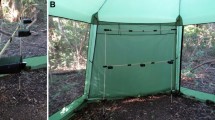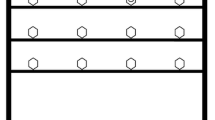Abstract
Animal individuals show patterns of behavior that are stable within individuals but different among individuals. Such individual differences are potentially associated with differences in foraging efficiency and in fitness. Furthermore, behavioral responses may be correlated in specific suites of so-called behavioral syndromes that are consistent across different contexts and with time. Here, we present a field investigation on individual differences between wild, free-flying nectarivorous bats (Glossophaga commissarisi) in the foraging context. We further investigated how individual differences affect choice performance, and we examined their interdependence within hypothesized behavioral syndrome structures. Free-ranging bats were individually identified as they visited an array of 24 artificial flowers with nectar of high or low sugar concentration. We found that three behavioral measures of foraging behavior were individually stable over the two-month observation period. We investigated the link between individual behavioral measures and measures of choice performance using generalized linear mixed models. Individual measures of choice performance showed significant repeatability, and we found evidence that bats making more visits per bout tend to be slower in learning to avoid unprofitable flowers. We used a multi-response generalized linear mixed model to estimate between-individual correlations and compare hypothesized syndrome structures. There were no clear patterns of between-individual correlations among the behavioral measures in our study, despite the measures exhibiting significant repeatability. This may indicate that foraging behavior depends on multiple individual behavior dimensions that are not adequately described by simple models of behavioral syndromes.
Significance statement
Nectar-feeding bats, like other animals including humans, have their own peculiar ways of consuming food that differ among individuals of the same species. We characterized the feeding habits of individuals in a population of wild, free-flying bats that were trained to gather nectar from computer-automated artificial flowers in a Costa Rican rainforest. Individual bats responded to the experimental conditions in different ways, but consistently over the two-month observation period. For example, some bats frequently returned to the same flowers, while others tended to meticulously probe most flowers they encountered before returning to a previously visited location. Interestingly, bats also consistently differed in how fast they learned to avoid flowers with dilute nectar and the faster learners were the bats that made only a few visits on each feeding trip. This suggests that individual foraging strategies might be associated with differences in foraging efficiency.



Similar content being viewed by others
References
Beekman M, Jordan LA (2017) Does the field of animal personality provide any new insights for behavioral ecology? Behav Ecol 28:617–623. https://doi.org/10.1093/beheco/arx022
Bell AM (2007) Future directions in behavioural syndromes research. Proc R Soc Lond B 274:755–761. https://doi.org/10.1098/rspb.2006.0199
Bell A, Hankison S, Laskowski K (2009) The repeatability of behaviour: a meta-analysis. Anim Behav 77:771–783. https://doi.org/10.1016/j.anbehav.2008.12.022
Benjamini Y, Hochberg Y (1995) Controlling the false discovery rate: a practical and powerful approach to multiple testing. J R Stat Soc B 57:289–300
Benus RF, Bohus B, Koolhaas JM, van Oortmerssen GA (1991) Heritable variation for aggression as a reflection of individual coping strategies. Experientia 47:1008–1019
Coppens CM, de Boer SF, Koolhaas JM (2010) Coping styles and behavioural flexibility: towards underlying mechanisms. Philos Trans R Soc B 365:4021–4028. https://doi.org/10.1098/rstb.2010.0217
Daw ND, O’Doherty JP, Dayan P, Seymour B, Dolan RJ (2006) Cortical substrates for exploratory decisions in humans. Nature 441:876–879. https://doi.org/10.1038/nature04766
Dingemanse NJ, Dochtermann NA (2013) Quantifying individual variation in behaviour: mixed-effect modelling approaches. J Anim Ecol 82:39–54. https://doi.org/10.1111/1365-2656.12013
Dingemanse NJ, Réale D (2005) Natural selection and animal personality. Behaviour 142:1159–1184. https://doi.org/10.1163/156853905774539445
Dingemanse NJ, Dochtermann N, Wright J (2010) A method for exploring the structure of behavioural syndromes to allow formal comparison within and between data sets. Anim Behav 79:439–450. https://doi.org/10.1016/j.anbehav.2009.11.024
Dingemanse NJ, Dochtermann NA, Nakagawa S (2012) Defining behavioural syndromes and the role of “syndrome deviation” in understanding their evolution. Behav Ecol Sociobiol 66:1543–1548. https://doi.org/10.1007/s00265-012-1416-2
Dochtermann NA, Jenkins SH (2007) Behavioural syndromes in Merriam’s kangaroo rats (Dipodomys merriami): a test of competing hypotheses. Proc R Soc Lond B 274:2343–2349. https://doi.org/10.1098/rspb.2007.0622
Dochtermann NA, Jenkins SH (2011) Multivariate methods and small sample sizes. Ethology 117:95–101. https://doi.org/10.1111/j.1439-0310.2010.01846.x
Dochtermann NA, Schwab T, Sih A (2015) The contribution of additive genetic variation to personality variation: heritability of personality. Proc R Soc B 282:20142201. https://doi.org/10.1098/rspb.2014.2201
Fisher DN, Brachmann M, Burant JB (2018) Complex dynamics and the development of behavioural individuality. Anim Behav 138:e1–e6. https://doi.org/10.1016/j.anbehav.2018.02.015
Gallistel CR, Fairhurst S, Balsam P (2004) The learning curve: implications of a quantitative analysis. PNAS 101:13124–13131. https://doi.org/10.1073/pnas.0404965101
Glimcher PW (2011) Understanding dopamine and reinforcement learning: the dopamine reward prediction error hypothesis. Proc Natl Acad Sci U S A 108:15647–15654. https://doi.org/10.1073/pnas.1014269108
Gosling SD (2001) From mice to men: what can we learn about personality from animal research? Psychol Bull 127:45–86. https://doi.org/10.1037/0033-2909.127.1.45
Gould TD, Gottesman II (2006) Psychiatric endophenotypes and the development of valid animal models. Genes Brain Behav 5:113–119. https://doi.org/10.1111/j.1601-183X.2005.00186.x
Guillette LM, Reddon AR, Hoeschele M, Sturdy CB (2011) Sometimes slower is better: slow-exploring birds are more sensitive to changes in a vocal discrimination task. Proc R Soc Lond B 278:767–773. https://doi.org/10.1098/rspb.2010.1669
Hadfield JD (2010) MCMC methods for multi-response generalized linear mixed models: the MCMCglmm R package. J Stat Softw 33:1–22. https://doi.org/10.18637/jss.v033.i02
Jeanniard-du-Dot T, Trites AW, Arnould JPY, Guinet C (2017) Reproductive success is energetically linked to foraging efficiency in Antarctic fur seals. PLoS One 12:e0174001. https://doi.org/10.1371/journal.pone.0174001
Koolhaas JM, de Boer SF, Buwalda B, van Reenen K (2007) Individual variation in coping with stress: a multidimensional approach of ultimate and proximate mechanisms. Brain Behav Evol 70:218–226. https://doi.org/10.1159/000105485
Lemon WC (1991) Fitness consequences of foraging behaviour in the zebra finch. Nature 352:153–155. https://doi.org/10.1038/352153a0
Mathot KJ, Wright J, Kempenaers B, Dingemanse NJ (2012) Adaptive strategies for managing uncertainty may explain personality-related differences in behavioural plasticity. Oikos 121:1009–1020. https://doi.org/10.1111/j.1600-0706.2012.20339.x
Muchhala N, Thomson JD (2009) Going to great lengths: selection for long corolla tubes in an extremely specialized bat-flower mutualism. Proc R Soc Lond B 276:2147–2152. https://doi.org/10.1098/rspb.2009.0102
Mutzel A, Dingemanse NJ, Araya-Ajoy YG, Kempenaers B (2013) Parental provisioning behaviour plays a key role in linking personality with reproductive success. Proc R Soc B 280:20131019. https://doi.org/10.1098/rspb.2013.1019
Nachev V (2018) ontogenerator/cpdetectorr: Turquoise. Zenodo. https://doi.org/10.5281/zenodo.1220161
Nachev V, Winter Y (2012) The psychophysics of uneconomical choice: non-linear reward evaluation by a nectar flower. Anim Cogn 15:393–400. https://doi.org/10.1007/s10071-011-0465-7
Nachev V, Winter Y (2018) Repeatability and foraging performance in wild free-flying nectarivorous bats (Glossophaga commissarisi). Zenodo https://doi.org/10.5281/zenodo.1446479
Nachev V, Stich KP, Winter Y (2013) Weber’s law, the magnitude effect and discrimination of sugar concentrations in nectar-feeding animals. PLoS One 8:e74144. https://doi.org/10.1371/journal.pone.0074144
Nachev V, Stich KP, Winter C, Bond A, Kamil A, Winter Y (2017) Cognition-mediated evolution of low-quality floral nectars. Science 355:75–78. https://doi.org/10.1126/science.aah4219
Nakagawa S, Schielzeth H (2010) Repeatability for Gaussian and non-Gaussian data: a practical guide for biologists. Biol Rev 85:935–956. https://doi.org/10.1111/j.1469-185X.2010.00141.x
Ohashi K, Thomson JD (2005) Efficient harvesting of renewing resources. Behav Ecol 16:592–605. https://doi.org/10.1093/beheco/ari031
Paton DC, Carpenter FL (1984) Peripheral foraging by territorial rufous hummingbirds: defense by exploitation. Ecology 65:1808–1819. https://doi.org/10.2307/1937777
Penke L, Denissen JJA, Miller GF (2007) The evolutionary genetics of personality. Eur J Personal 21:549–587. https://doi.org/10.1002/per.629
R Development Core Team (2018) R: a language and environment for statistical computing. R Foundation for Statistical Computing, Vienna, http://www.R-project.org
Réale D, Reader SM, Sol D, McDougall PT, Dingemanse NJ (2007) Integrating animal temperament within ecology and evolution. Biol Rev 82:291–318. https://doi.org/10.1111/j.1469-185X.2007.00010.x
Ritchie ME (1990) Optimal foraging and fitness in Columbian ground squirrels. Oecologia 82:56–67. https://doi.org/10.1007/BF00318534
Roche DG, Careau V, Binning SA (2016) Demystifying animal ‘personality’ (or not): why individual variation matters to experimental biologists. J Exp Biol 219:3832–3843. https://doi.org/10.1242/jeb.146712
Rosseel Y (2012) lavaan: an R package for structural equation modeling. J Stat Softw 48:1–36. https://doi.org/10.18637/jss.v048.i02
Sih A, Del Giudice M (2012) Linking behavioural syndromes and cognition: a behavioural ecology perspective. Philos Trans R Soc B 367:2762–2772. https://doi.org/10.1098/rstb.2012.0216
Sih A, Bell AM, Johnson JC (2004) Behavioral syndromes: an ecological and evolutionary overview. Trends Ecol Evol 19:372–378. https://doi.org/10.1016/j.tree.2004.04.009
Sih A, Mathot KJ, Moirón M, Montiglio P-O, Wolf M, Dingemanse NJ (2015) Animal personality and state–behaviour feedbacks: a review and guide for empiricists. Trends Ecol Evol 30:50–60. https://doi.org/10.1016/j.tree.2014.11.004
Thiele J (2006) Nahrungssuchstrategien der nektarivoren Fledermaus Glossophaga commissarisi (Phyllostomidae) im Freiland - eine individuenbasierte Verhaltensstudie unter Verwendung von Transpondertechnik. Dissertation, Ludwig Maximilian University, http://edoc.ub.uni-muenchen.de/5566/
Tschapka M (2004) Energy density patterns of nectar resources permit coexistence within a guild of Neotropical flower-visiting bats. J Zool 263:7–21. https://doi.org/10.1017/S0952836903004734
Winter Y, Stich KP (2005) Foraging in a complex naturalistic environment: capacity of spatial working memory in flower bats. J Exp Biol 208:539–548. https://doi.org/10.1242/jeb.01416
Wolf M, van Doorn GS, Leimar O, Weissing FJ (2007) Life-history trade-offs favour the evolution of animal personalities. Nature 447:581–584. https://doi.org/10.1038/nature05835
Wolf M, van Doorn GS, Weissing FJ (2008) Evolutionary emergence of responsive and unresponsive personalities. Proc Natl Acad Sci U S A 105:15825–15830. https://doi.org/10.1073/pnas.0805473105
Acknowledgments
We thank Arne Jungwirth for fieldwork assistance and Alexej Schatz for software programming, as well as Jerry Wilkinson and the anonymous reviewers, whose comments greatly helped improve this manuscript.
Funding
This work was supported by the National Geographic Society (8579-08), the Deutsche Forschungsgemeinschaft (Exc257, Exc277), and the Volkswagen Foundation (84915 to VN).
Author information
Authors and Affiliations
Corresponding author
Ethics declarations
Conflict of interest
The authors declare that they have no conflict of interest.
Ethical approval
This is a reanalysis of a previously published study. Treatment of the experimental animals in that study complied with the national laws on animal care and experimentation.
Additional information
Communicated by G. S. Wilkinson
Publisher’s note
Springer Nature remains neutral with regard to jurisdictional claims in published maps and institutional affiliations.
Rights and permissions
About this article
Cite this article
Nachev, V., Winter, Y. Behavioral repeatability and choice performance in wild free-flying nectarivorous bats (Glossophaga commissarisi). Behav Ecol Sociobiol 73, 24 (2019). https://doi.org/10.1007/s00265-019-2637-4
Received:
Revised:
Accepted:
Published:
DOI: https://doi.org/10.1007/s00265-019-2637-4




